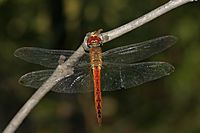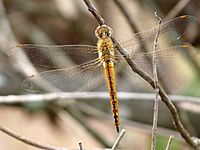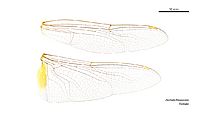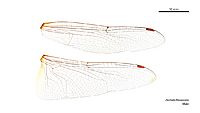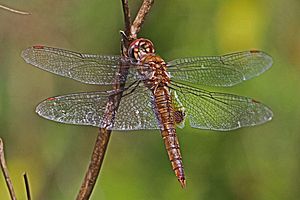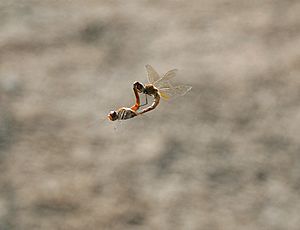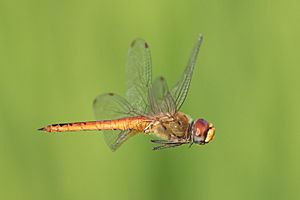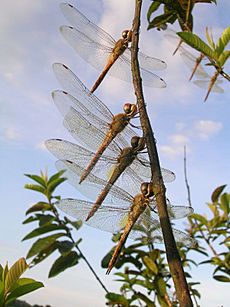Globe skimmer facts for kids
Quick facts for kids Globe skimmer |
|
|---|---|
 |
|
| male, Kerala, India | |
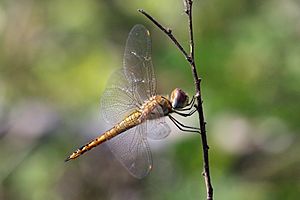 |
|
| female, Grand Cayman, Cayman Islands | |
| Conservation status | |
| Scientific classification | |
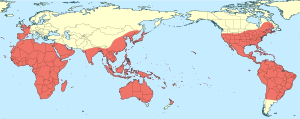 |
|
| Distribution of Pantala flavescens | |
| Synonyms | |
|
The Pantala flavescens, also known as the globe skimmer or wandering glider, is an amazing dragonfly. It belongs to the Libellulidae family, which includes many common dragonflies. This species and the "spot-winged glider" (Pantala hymenaea) are the only two types in their genus called Pantala.
The globe skimmer was first described way back in 1798. It's known as the most widespread dragonfly on Earth! You can find it on every continent except Antarctica. It's not very common in Europe, though. These incredible insects make a huge journey every year, traveling about 18,000 kilometers (11,200 miles). Each individual dragonfly flies more than 6,000 kilometers (3,730 miles) during this trip. This makes it one of the longest known migrations for any insect!
Contents
What it Looks Like
Adult globe skimmers can grow up to 4.5 centimeters (about 1.8 inches) long. Their wingspan, which is the distance from one wingtip to the other, can be between 7.2 and 8.4 centimeters (about 2.8 to 3.3 inches).
The front of their head is usually yellowish or reddish. Their body, called the thorax, is often yellow or golden with a dark, fuzzy line. Some globe skimmers might even have a brown or olive-colored thorax. Their belly, or abdomen, is usually the same color as their thorax.
Their wings are clear and very wide near their body. Some dragonflies of this species have olive, brown, or yellow wings. Interestingly, on Easter Island, you can find wandering gliders with black wings! The small, colored spot on their wings, called the pterostigma, is yellowish. Sometimes, the clear parts of their wings can also look a bit yellowish near the tips.
Like many large dragonflies, their big, chestnut-red eyes cover most of their head. These different colors explain why scientists have described this species under many different names over time.
Male vs. Female Differences
Male and female globe skimmers look a bit different. Males usually have a reddish-yellow abdomen with black markings. Females, however, don't have this reddish color on their abdomen.
Males also have a golden-yellow patch at the base of their back wings. They also have a small, narrow brown spot at the outer edge of their back wings. Females do not have these brown spots on their wings.
Dragonflies living on continents can have different leg and wing lengths compared to those living on islands. Island dragonflies are generally darker in color.
Baby Dragonflies (Larvae)
The baby globe skimmer, called a larva, is about 24 to 26 millimeters (about 1 inch) long. It's light green with small, light brown spots. Its round eyes are on the sides of its head, and its abdomen and tail are blunt.
The larva has special plates on its tail end. These plates help scientists tell them apart from other dragonfly larvae. For example, the top plate (epiproct) is about the same length or longer than the side plates (paraprocts). This is different from Tramea larvae, where the epiproct is shorter. Also, the mouthparts of Pantala flavescens larvae have fewer bristles than those of P. hymenaea larvae.
Similar Dragonflies
The globe skimmer can sometimes be confused with the "spot-winged glider," Pantala hymenaea. However, the spot-winged glider has a clear brown spot at the base of its back wings and is usually a bit darker overall.
It might also look like a dragonfly from the Tramea genus. But Tramea dragonflies usually have a clear stripe on their back wings, which the globe skimmer does not.
Life Cycle
Reproduction and Development
Unlike some animals, globe skimmers don't have a special dance or ritual before mating. Females can mate many times, but usually only once a day.
After mating, the male and female dragonflies fly together. The female then lays her eggs, often while the male is still connected to her. A female can lay a lot of eggs, usually between 500 and 2000! The eggs are round, like tiny spheres.
The larvae grow and develop in about 38 to 65 days. This quick development allows these migrating dragonflies to lay eggs and have their young grow up even in temporary puddles or swimming pools! However, the larvae are very sensitive to temperature changes. We don't know exactly how long an adult globe skimmer lives because they move around so much, making it hard to track them.
What They Eat
Globe skimmer larvae are predators, just like all dragonfly larvae. They actively hunt and eat almost any small aquatic animal they can find. This includes other insect larvae and tiny shrimp. They even eat small fish and tadpoles!
Adult globe skimmers mostly eat small flying insects. This includes mosquitoes, swarms of flying ants, and termites.
How They Fly
These dragonflies are very noticeable. You might see them flying in large groups over fields, playgrounds, or open areas. They fly tirelessly for hours, often without stopping to rest. Their flight speed can reach up to 5 meters per second (about 11 miles per hour)!
Especially in the autumn, globe skimmers fly in huge swarms. They use warm air currents, called thermals, to help them glide. One report even described a "cloud" of these dragonflies covering an area of 34 square kilometers (about 13 square miles)! They prefer to fly in moist winds.
When they land, they usually try to sit in an upright position. Like all large dragonflies, they hold their wings out from their body when they are resting.
Where They Live and Travel
As their name suggests, the globe skimmer lives in many places around the world. You can find them in areas where the average yearly temperature is above 20 degrees Celsius. This generally means between the 40th parallel north and south of the equator.
In Europe, you don't see them very often. Most sightings are around the Aegean Sea. It's thought that the dry winds from the Sahara desert make it hard for them to cross into Europe.
Their arrival in warmer parts of the world, like the subtropics and tropics, often happens when the Intertropical Convergence Zone moves. This is a band of low pressure that brings a lot of rain. This shows that these dragonflies prefer moist winds. For example, they only migrate to Southeast India after the second monsoon, which brings rain to that area. In other parts of India, they arrive with the first monsoon. Scientists believe they migrate from India or even further east, all the way to Africa, by flying across the Arabian Sea.
The globe skimmer is also the highest-flying dragonfly. It has been seen flying at an amazing 6,200 meters (over 20,000 feet) high in the Himalayas! It was also the first dragonfly species to settle on Bikini Atoll after the nuclear tests there. On Easter Island, it's the only type of dragonfly you'll find. These island dragonflies seem to have developed slightly differently from their mainland relatives over time.
In colder places like South Australia and Southern Canada, these dragonflies cannot survive the winter. So, new globe skimmers have to migrate to these areas each year.
Recent studies by biologists at Rutgers University-Newark show that this dragonfly is the insect that travels the longest distance in the world. Genetic tests from dragonflies all over the globe suggest that these small insects fly huge distances to find mates. This helps create a single, large group of dragonflies worldwide, meaning they are all very closely related.
Naming
Common Names
The English names "wandering glider" and "globe skimmer" both refer to how much these dragonflies travel. In German, its name Wanderlibelle also means "migrant dragonfly."
In Hong Kong, people call it the "typhoon dragonfly" because it often arrives with or just before the seasonal rains. The Japanese name, usubaki-tombo, means "yellow dragonfly with delicate wings." In South Korea, it's called '된장잠자리' (doenjang dragonfly) because its color is similar to a traditional Korean bean paste called doenjang.
Scientific Name
The scientific name is Pantala flavescens. The first part, Pantala, means "all wings," which makes sense because of its big, long wings. The second part, flavescens, comes from a Latin word meaning "yellowish." This refers to its distinct golden color.
Protection Status
The globe skimmer is considered a very common and widespread species around the world. It has a conservation status of G5, which means it is secure and abundant globally. This status was given on December 30, 1985. In the United States, it also has a high protection status. In Canada, it's considered "apparently secure," meaning it's not rare but there's some long-term concern. Even so, it's protected in many parts of the US and Canada.
Postage Stamps
Because the globe skimmer is found in so many places, it has appeared on several postage stamps around the world.
For example, Wallis and Futuna released a stamp with a globe skimmer in 1974. The Pitcairn Islands also featured one on a stamp in 1975. Tuvalu had a globe skimmer on a stamp in 1983, and Botswana also featured one. Wallis and Futuna released another stamp with this dragonfly in 1998. The most recent stamp featuring a globe skimmer came from North Korea in 2003.
Images for kids



